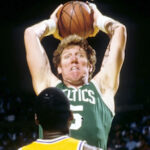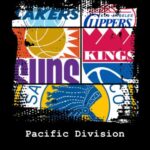We have two related stories today. The first is about the lowest scoring game in NBA history, which directly leads to the second story about the invention of the shot clock.
An Absolute Debacle – Minneapolis Lakers vs Ft. Wayne Pistons
On Wednesday, November 22, 1950, the Minneapolis Lakers were playing host to the Ft. Wayne Pistons, who later became the Detroit Pistons. So let me set the scene for you. On that night the Lakers were the reigning two-time defending NBA Champions. They were an extremely tough team loaded with Hall of Famers like Slater Martin, Jim Pollard, Vern Mikkelsen, and the big man in the middle, George Mikan. Mikan was the first true superstar of the NBA.
It also happened to be Father-Son night at the Minneapolis Auditorium. The promotion said that for just 50 cents a father and son could get two seats to see their beloved champions. The place was packed as a bunch of dads wanted to show their sons the wonderful and amazing game of professional basketball. But what they got that night was the basketball equivalent of watching paint dry.
The Lakers, back then, played a slow style of basketball. And they did so for one basic reason, George Mikan, their leader, was not that fast. At 6’10” (208 cm) he was the tallest and most dominant player in the NBA, but also one of the slowest. If they got the defensive rebound, they were in no hurry to get down the court. The fast break was not in their wheelhouse.
They would basically wait for Mikan to drag his lumbering body down the court and then they would set up their half-court offense. While it wasn’t exciting, it was very, very effective. The Lakers would win five championships in their first six years in the league using this style with this core group of players.
The Pistons Decide to Stall
But on this night, Murray Mendenhall, the coach of the Pistons, came up with an ingenious game plan. He wanted to take the slow pace of the Lakers and slow it down even more.
I mean, he wanted to slow it down to a snail’s pace. He figured that their best chance to win was to seriously reduce the number of possessions and hope they get lucky.
The Pistons won the opening tip, so the Lakers quickly ran back on defense. When they turned around they saw Larry Foust from the Pistons just standing near midcourt with the ball on his hip, like he was waiting for the bus or something.
The Pistons would hold the ball for as long as four minutes at a time, just standing with it. At the time there was nothing in the rules that said how long a team could take before shooting the ball. It was not uncommon for teams of the day to just stall and hold the ball if they had a good lead late in a game. In those late-game situations, the best strategy was to run out the clock and stalling helped you do that. But, to use a stalling strategy from the very beginning of the game was something else entirely.
Again, the Pistons coach felt that this was their best chance to win. For that, I do not blame him. If I were the coach I would push the rules to their absolute limit in order to win a game. Besides, if they had decided to play a normal game, there was a really good chance that they would lose because the Lakers were just that good.
As you can imagine, the fans booed and screamed for something to happen. The first quarter ended with the score 8 to 7 in the Pistons’ favor. Nobody was happy about this except the Pistons. The second quarter was no better as the score at halftime was 13-11, Lakers. Going into the fourth quarter it was still only 17-16 Lakers. This was abysmal. Each team made a single free throw in the fourth quarter and went down to the final minute with the Lakers leading 18-17.
The Pistons run a play for Foust to attack the rim and he launched a shot that just cleared Mikan’s outstretched arms and went in. Pistons were now in the lead. With a few seconds left the Lakers took a Hail Mary shot that missed and the Pistons walk away with a 19-18 victory.
The Fallout
The fans were furious. John Kundla, the coach of the Lakers, was furious. He said that he wanted no part of basketball if that is the way it was going to be played. The league commissioner, Maurice Podoloff, was also furious when he found out the next day. He sent a message to all of the teams in the league letting them know that this kind of game was to never happen again because it would kill the league. And he was right. If the NBA had allowed this type of play to continue, the league would have gone out of business in the 1950s.
At the time the league was becoming very stable, but not that stable. At this point in the leagues’ history, there was nobody who was getting rich playing in it. Nearly every player, even the stars, still had other jobs in the off-season, like selling insurance or working as real estate agents. Each team clearly understood the need to contribute to growing this league and making it something exciting that people would want to buy a ticket to watch.
If there was a Hall of Shame, this game would definitely be in it. The game set all kinds of scoring records that still stand today. But these are not the records that anyone should be proud of. Here are just a handful of the records set that night:
- Fewest points by one team.
- Fewest points by both teams together
- Fewest shots attempted
- Fewest shots made
- Fewest points for a single quarter.
You get the point.
So keeping the game exciting was of the utmost importance. They had to sell tickets and grow their fan base. Scores of 19-18 were not going to cut it. So, while each team was committed to playing the game the right way to attract fans, one of the league owners also knew that they had to put in a rule to prevent some team in the future from pulling the same stunt.
The Need For A Shot Clock
And this is where we go into our second story about the shot clock. The owner of the Syracuse Nationals was a man named Danny Biasone. By the way, the Nationals would later become the Philadelphia 76ers. Well, Biasone had an idea to make sure that the game speeds up and stays speeded up. His idea was a shot clock, something that would force teams to shoot or turn the ball over to the other team.
Why 24 Seconds For The Shot Clock?
But you could not just buy one at a sporting goods store. He had to build one from scratch in his garage. He tinkered with it for quite a while. At the same time, he was also working to convince his fellow owners to adopt a rule change that would bring the shot clock into the game. His idea was to make it a 24-second shot clock.
So, why 24 seconds? Well, he went through the box scores from the previous season and realized that teams averaged 60 shots per game. So, when you have two teams that means there are 120 shots per game in total. If you take into consideration that the game is 48 minutes long, it means that a shot is taken every 24 seconds, on average. He thought, let’s take that average of 24 seconds and make that the limit. If a team cannot take a shot within 24 seconds, the other team would automatically get the ball.
The clock that Biasone came up with was like a big aluminum box with lights on it that counted down from 24 seconds to zero. It sat on the floor a couple of feet off the baseline on each end of the court. To finally get the rule changed there was a meeting of the NBA board of governors in Syracuse, NY where the Nationals played. They met at Vocational High School in August of 1954. This is three seasons after our infamous 19-18 game. Because sometimes change takes a while. On that day Biasone had set up a scrimmage between his Nationals players using the new shot clock.
So, with representatives present from each of the other teams in the league, they got a chance to see what the game would look like with a shot clock. Once they saw the scrimmage they voted unanimously to add the shot clock to the NBA game.
They found a manufacturer to make a bunch of clocks based on Biasone’s design and sent them to each of the 9 teams in the league at that time. Yeah, there were only 9 teams in the league back then.
The Shot Clock Worked!
The shot clock was an immediate success. Scores around the league jumped. The season before the clock NBA teams averaged around 80 points per game. Under the new shot clock, average scores jumped up to just under 94 points per game. But most importantly the fans loved it. Ticket sales were up, local TV stations were looking to start putting the games on the air, which now brought in TV revenue. And it also added a new level of financial stability to the league. Prior to the shot clock, 15 different NBA teams had gone out of business throughout the league’s history. Some of those teams were the Toronto Huskies, The Pittsburgh Ironmen, The Detroit Falcons, and The Providence Steamrollers. But since the invention of the shot clock, not a single NBA team has gone out of business.
The newer, faster style of play completely changed the game. The slow-down offense that the Minneapolis Lakers used to run with George Mikan completely disappeared. In fact, Mikan himself decided to retire three days before the start of training camp for the 1954-1955 season when the shot clock would be introduced. Even though he was only 30 years old, he knew his time had come. He could not keep up with the new speed. He had become a dinosaur overnight and he had the presence of mind to realize it and bow out gracefully. Thankfully, he had already earned his law degree and immediately opened his own law practice in Minneapolis upon his retirement.
The original commissioner called it “the single most important rule change” in league history. And I agree with that sentiment. Bill Simmons, the basketball writer, once joked that America should create a $24 bill and put Danny Biasone’s picture on it.
The League Has Never Been The Same
Just a few years later in 1958, the Boston Celtics beat the Minneapolis Lakers 173-139. The league has not been the same since.
And guess who won the 1955 championship? The first one with the shot clock? None other than the Syracuse Nationals… owned by Danny Biasone. Talk about putting a feather in your cap.
The invention of the shot clock would warrant Biasone’s election to the Basketball Hall of Fame, but unfortunately, that didn’t happen until the year 2000, 8 years after he died. He should have been in there way sooner. But at least he is in there. I have been to the Hall of Fame and his original shot clock is on display there. It is actually pretty cool to look at. As I stared at the box I thought to myself, “that box saved the NBA.”
And the part that is amazing is that today in the year 2020, 65 years after the invention of the shot clock, it is still at 24 seconds. It has never needed to be adjusted. That is an amazing thing.
So, we salute you, Danny Biasone. Your invention saved the league and serves as a pillar for what the game is today.
More From Basketball History 101
Bill Walton’s Feet: A Legacy of Pain and Progress
How does a player who spent 14 seasons in the...
Read MoreHistory of NBA Team Nicknames: Atlantic Division
I love the history of sports team nicknames. Today I...
Read MoreHistory of NBA Team Nicknames: Pacific Division
I love the history of sports team nicknames. Today I...
Read MoreCheryl Miller – Greatest Women’s Basketball Player of All Time?
Imagine that you are one of the most skilled people...
Read More


